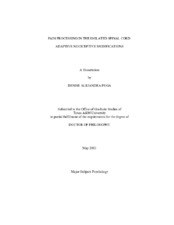| dc.description.abstract | We utilize a simple instrumental (response-outcome) learning task to measure
spinal plasticity in the isolated spinal cord. Peripheral uncontrollable nociceptive input
has been shown to disrupt spinal instrumental learning and induce enhance tactile
reactivity. In contrast, 1.5mA of continuous shock has been found to induce
antinociception and protect spinal plasticity from the detrimental consequences of
uncontrollable stimulation. The experiments of this dissertation examined the link
between the beneficial effects of continuous stimulation and antinociception.
The results replicated previous work examining the protective and
antinociceptive effect of 1.5mA of continuous shock (Experiments 1-2). Novel to this
research was the inclusion of a lower (0.5mA) intensity continuous stimulation. Results
revealed that 0.5mA of continuous shock induced a comparable antinociception to that
seen with 1.5mA of continuous shock (Experiment 1). At this lower intensity, however,
continuous shock was unable to protect the isolated spinal cord from the detrimental
effect of intermittent stimulation (Experiment 2). Further examination revealed that co-administration of intermittent and continuous shock did not affect continuous shockinduced
antinociception. This was true at both the higher (1.5mA) and lower (0.5mA)
intensities of continuous shock (Experiment 3).
When 0.5mA of continuous shock was administered prior to intermittent shock,
this intensity of continuous shock was better able to immunize the spinal cord from the
induction of the learning deficit than 1.5mA (Experiment 4). Further analysis called into
question the link between antinociception and the protective effect of continuous shock,
as the beneficial effect of continuous shock outlasted the expression of antinociception
(Experiment 5). Moreover, 0.5mA of continuous shock was found to reverse the
expression of the learning deficit, when continuous stimulation was given after
intermittent shock treatment (Experiment 6).
While blocking the induction of antinociception was not sufficient to prevent the
immunizing effect of continuous shock, data suggest that the mu opioid receptor is
implicated in the beneficial impact of continuous stimulation (Experiments 7 and 8).
Endogenous brain derived neurotrophic factor (BDNF) release was also found to play a
role (Experiment 9). Moreover, continuous shock was found to down-regulate the
expression of early genes implicated in the development of central sensitization, c-fos
and c-jun. Finally, we found that while continuous stimulation was detrimental to
locomotor recovery after spinal cord injury, the combined treatment of continuous and
intermittent shock did not negatively affect recovery (Experiments 11 and 12). | en |


